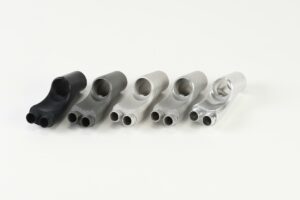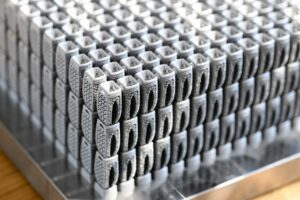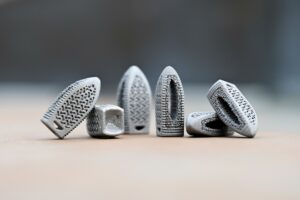Building Trust, Layer by Layer: How Qualification Ensures Reliable High-Performance AM Parts
Optimizing a traditionally manufactured application for additive manufacturing requires a complex set of steps.
Posted: July 30, 2024

Industrial 3D printing, or additive manufacturing (AM), has the potential to transform how everything from prosthetics to complex aerospace components are designed and produced. However, for AM to disrupt established manufacturing processes, there is a crucial hurdle to overcome with ensuring consistent part quality and performance.
This is where requirements for part qualification come in — a rigorous process that verifies additively manufactured parts meet the same stringent standards as their traditionally manufactured counterparts. In sum, qualification paves the way for broader adoption of AM by demonstrating that every part within the production process meets the rigorous requirements set for critical applications.
Building Trust Through Testing

Current AM qualification processes rely on a sequence of mechanical property tests customized to meet individual component requirements. These tests consider factors like the specific machine used, the materials involved, the printing parameters chosen, software control, post-processing steps and more. The frequency and intensity of testing is directly linked to the overall risk associated with the application’s end use and differs by industry. High-risk applications, like airplane wing slats or medical implants, require more stringent testing, data requirements and qualification procedures compared to simple decorative items like 3D printed jewelry.
By analyzing the results of these tests, manufacturers can establish “statistical equivalence.” This means demonstrating that the additively manufactured parts consistently meet the required performance standards. The aim is to build confidence that any future part produced using the same parameters will function as expected.
However, AM technology’s unique characteristics necessitate a different set of rules and certification schemas. Existing guidelines designed for traditional manufacturing methods sometimes struggle to accommodate the capabilities of AM.

Further complicating the situation is the rapid growth and widespread potential of the AM industry, with influx of in-situ monitoring (ISM) techniques, closed loop feedback control and data-driven AI/ML models to speed up the qualification process. While sectors like aerospace, automotive and medical applications have developed bespoke standards and practices to address AM qualification, other areas such as semiconductors and energy have limited, evolving guidelines. This disparity creates confusion for manufacturers venturing into new additively produced applications. They face difficulties identifying the precise standards and protocols relevant to their specific needs.
The widely accepted qualification process is typically divided into three crucial stages: Installation Qualification (IQ), Operational Qualification (OQ), and Performance Qualification (PQ).
Setting the Stage for Success
Building a house without a solid foundation would be a bad idea, right? Similarly, in an AM operation, IQ is the essential first step to ensure the entire system operates reliably.
During this stage, it’s crucial to verify that all critical aspects of the AM equipment, including the printer, powder handling systems and peripheral devices, are installed and functioning correctly as intended by the manufacturer(s).
This typically involves two key tests:
- FAT: Factory Acceptance Testing is conducted at the AM OEM’s facility before shipping the equipment to the customer. This test aims to ensure that the equipment meets the customer’s intended performance criteria. The OEM runs generic or custom test jobs during the FAT based on the customer’s specific requirements. Safety checks and machine conformity tests are also performed to ensure safe operation of the equipment.
- SAT: After the equipment reaches the customer’s site, a Site Acceptance Test (SAT) is performed to verify that the installation is done correctly, and the equipment is functioning as expected. This typically involves replicating the builds conducted during the FAT to demonstrate consistent performance throughout the shipping process. Standard procedures for IQ might involve running these test builds and ensuring all necessary safety checks and conformity tests are completed.
Establishing Control and Consistency
OQ is a critical step that ensures the equipment consistently produces high-quality parts. Imagine OQ as a recipe that unlocks the full potential of an AM system.
It involves establishing process controls such as precise machine settings, process parameters, and procedures that guarantee consistent material performance and repeatable builds. OQ acts as the essential link between having AM equipment and having the knowledge to use it effectively.
- Process Control and Material Performance: OQ is the science behind the material. It involves building test parts, including static and dynamic test coupons, that mirror the final product with additional features for detailed analysis. These specialized pieces serve two key functions. First, they validate the printing process’s effectiveness and repeatability for the specified material. This confirms that the selected settings consistently produce parts with the desired mechanical properties, surface finish, and dimensional accuracy. Second, the test parts establish a baseline for application design. By analyzing how the material behaves under specific printing conditions, businesses can optimize the actual part design for peak performance in its intended use.
Locking in Success for Production Runs
After establishing a strong foundation by measuring IQ and unlocking the system’s potential through OQ, PQ takes over. This is where the knowledge gained from rigorous testing and exploration is used in a controlled production process.
PQ acts like the final step in a high-security vault, ensuring that only authorized, thoroughly tested processes are used to unlock critical parts.
This stage involves:
- Part Design and Process Lock-in: During PQ, the focus narrows to locking down every aspect of the production process for a particular AM part. This involves meticulously documenting and finalizing the part design, ensuring no last-minute changes compromise its printability or performance. The job layout, which dictates how the part is positioned and oriented within the printing chamber, is also finalized to optimize build efficiency and minimize support structures.
Most importantly, all the crucial process parameters — factors like laser power, scan speed, and layer thickness — are definitively set. These parameters directly influence the final part’s properties, so ensuring their consistency is paramount. Finally, any necessary post-processing steps, such as heat treatment or surface finishing, are also rigidly defined. Any modifications made to the part design, process, or system would require re-qualification, which can be done by supplemental testing, to further validate and confirm that the part produced is safe to use.
- First Article Inspection (FAI) and Testing: PQ doesn’t stop at simply locking down these elements; it also involves rigorous FAI and testing. The very first batch of parts produced using the established process undergoes a variety of tests to verify they meet the stringent design specifications and performance requirements. This initial testing data often plays a crucial role in fulfilling certification requirements for specific applications, especially in highly regulated industries like aerospace or medical.
- Statistical Process Control (SPC) for Continuous Improvement: Manufacturers can improve their high-volume production runs by extending PQ with SPC. By doing so, they can continuously monitor and refine their processes. SPC utilizes statistical analysis to identify any potential variations and allows for adjustments to maintain consistent part quality that meet specifications. Essentially, PQ transforms the AM system from a versatile tool with immense potential into a reliable production line capable of churning out high-quality parts that meet exacting standards, time and time again.
Collaboration for a Standardized Future
Creating a comprehensive qualification process can be challenging. Each phase requires resources and without guidance, errors can occur. Manufacturers may create overly complex control plans or define inefficient qualification protocols, leading to wasted printing runs and extra expenses. Limited access to qualified AM personnel can also make it difficult for companies to create cost-effective test plans that balance efficiency with high-quality parts. This knowledge gap can hinder the adoption of AM technology within these companies.
However, regulatory bodies, research institutions and standardization organizations are actively involved in creating and updating technical guidelines for AM part certification and qualification. Industrial 3D printing OEMs, such as EOS, also provide consulting expertise in qualification and can assist with training and setting organizations’ standards based on manufacturing goals. Collaboration is key to establishing robust frameworks that bridge the gap between AM part qualification and the established standards for conventionally manufactured parts.








